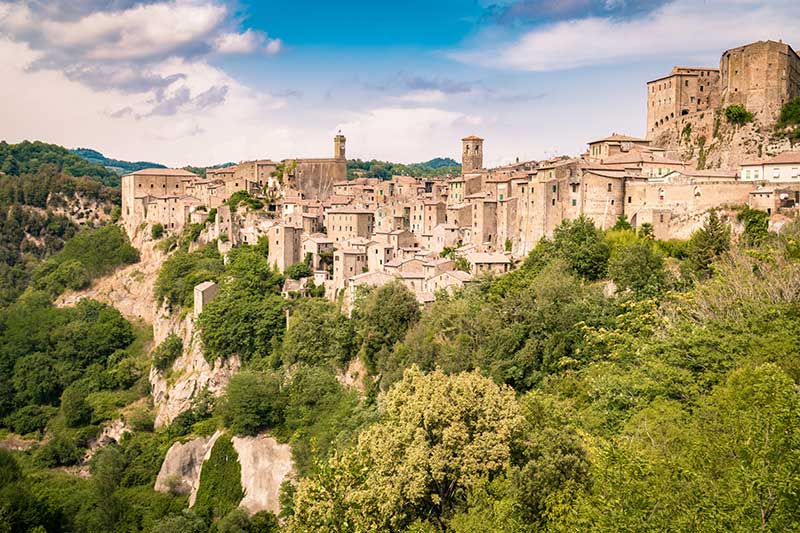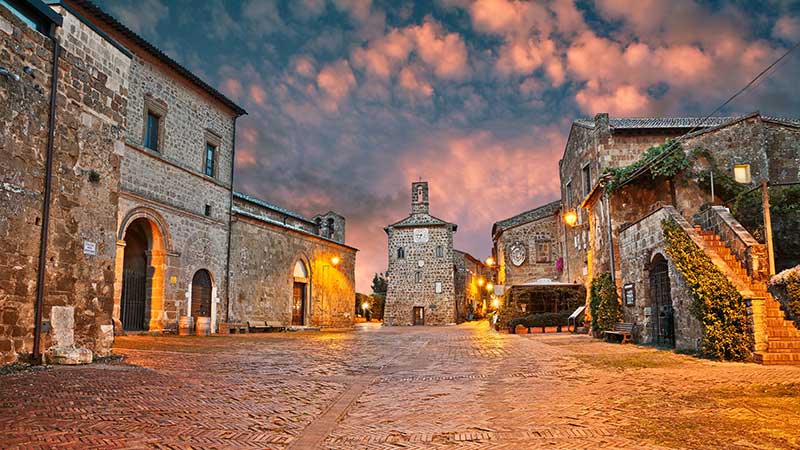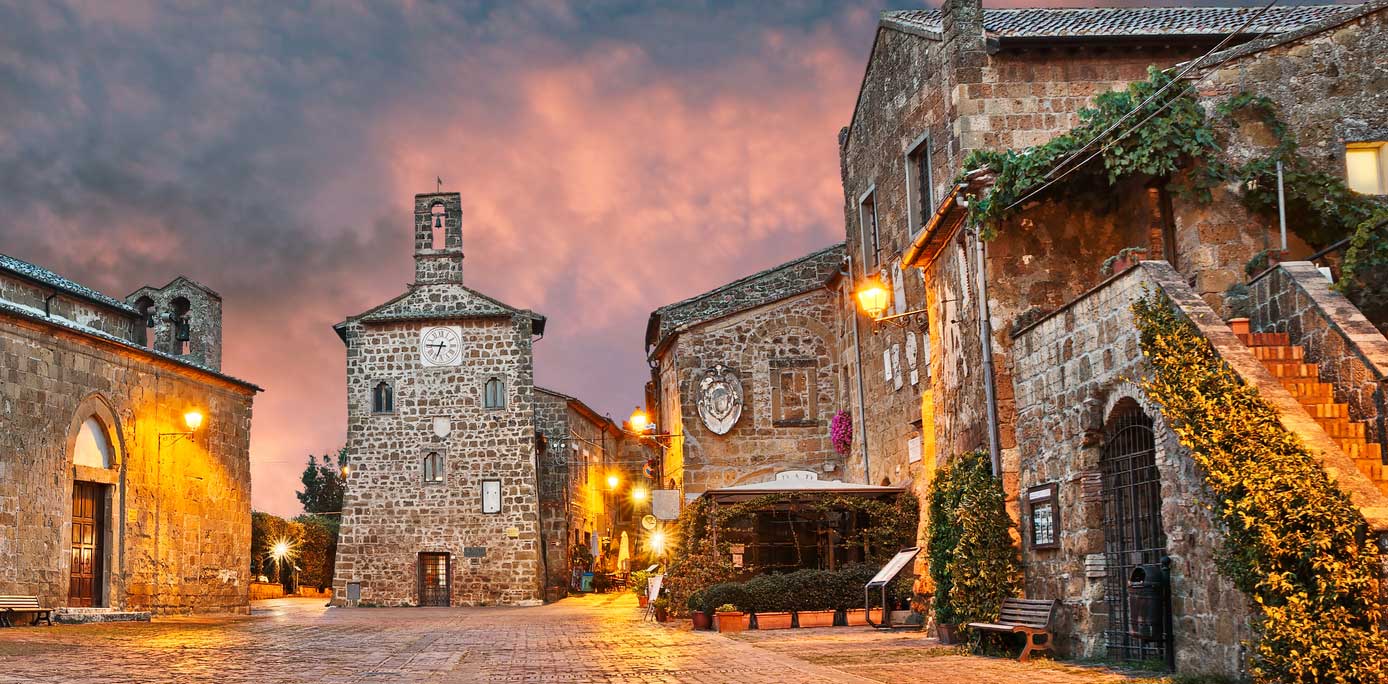The Etruscans are one of the most fascinating pre-Roman civilizations but, puzzlingly, also one of those we know the least about: the real Etruscan mystery is that of their origin and of their language, both of which remain largely unknown, in spite of the many theories advanced throughout the decades.
But that doesn’t mean they didn’t leave a plethora of archaeological vestiges for us to admire, study and enjoy, symbol and vision of the height of culture and knowledge they had reached. We usually hear about their necropolis, and about towns like Volterra, in the province of Pisa, that once was part of the Etruscan League. Not as famous are, however, their Vie Cave.

Vie Cave are, quite literally, roads carved into tufa rock © Jamie Frattarelli | Dreamstime.com
Vie Cave mean literally “hollow, excavated roads,” and they look like under-the-sky stone corridors traversing the area comprised within Pitigliano, Sovana and Sorano, in the southern part of Tuscany we all know as Maremma. Majestic and imposing, just as if Ulysses’ cyclops traveled to Tuscany to carve them out of tufa, they represent an important historical and cultural attraction.
But what are they, exactly?
Le Vie Cave — there are a few dozens of them — are walkaways carved in stone: they are usually between 2 and 4 meters wide and can be up to a kilometer long (just a bit short of half a mile), while the height of their rock walls can reach 25 meters. Walking through them is a magical experience for many, immersed as they are in nature, with tree branches often creating a leafy roof above them, the sunlight dimly shining through. And if you pay attention enough, you’ll notice there are carvings along their walls, too, secrets etched in stone, mirror to a past that, we have said, remains in large part still obscure. What’s even more interesting is that you won’t find anything like them anywhere else on earth.

The middle ages town Sorano
It is a world of suggestive atmospheres, that of the Vie Cave and, like much of what we know about the Etruscans they, too, hold mysteries within. To begin with, we don’t know exactly what their function was. Some believe they were ways of communications, and while they were certainly used as such, we don’t know whether they were conceived as roads or not. It remains the fact that many of them offer a shortcut through the countryside to reach a village or another, while others connect urban settlements to old Etruscan necropolis. Other theories say they were supposed to be defensive systems, but the most fascinating theory of all, certainly, is the one that wants them to be ritual or funerary monuments, as the tombs found inside their walls seem to bear witness to.
Whichever their ancestral meaning, it is incredible to think they were created so long ago, without the use of modern machinery and only with the sheer strength of human hands and, possibly, the help of animals for transport, even if tufa is a relatively soft stone to carve when wet.

They are usually between 2 and 4 meters wide and can be up to a kilometer long
Archeologists believe the Vie Cave didn’t always look the way they do today: in fact, it is possible that their bottom part, that where people would walk, used to be much higher than it is now. The Vie Cave’s depth we see today is probably the result of successive excavation processes carried out to smooth out their surface, often damaged by natural erosion and use.
Each Via Cava has specific characteristics: the Via Cava “del Cavone,” for instance, was without a doubt used with funerary purposes, as attested by the many archaic funerary chambers along its walls.

The magic atmosphere of Sovana © Ermess | Dreamstime.com
Such a mesmerizing and mysterious monument, of course, did attract the attention of Man way before our generations: and so, you shouldn’t be surprised to learn that, in the Middle Ages, people used to draw and carve protective images on their walls and that many a niche were created to hold holy images and statuettes, as a sign of protection for travelers.
The Vie Cave are also interesting from a natural point of view: because of their conformation, they developed a peculiar microclimate where the flora typical of shady and humid environments can thrive. Lichens, moss, ivy, ferns: emerald and dusty greens fading into each other in a beautiful game of hues that speaks of enchanted fables and mysterious tales.
Vie Cave were used as a way of communication until relatively recent times, but today they no longer are: it is trekkers who walk through them, to enjoy their peculiar charm and get the feeling of walking through millennia.
If the history and the mystery of these ancient roads wasn’t enough, there is also the fact we are in one of the most charming spots of Tuscany: Pitigliano, Sorano and Sovana are picturesque locations full of history. Indeed, if you were interested to use the Vie Cave as a way to discover the area, you may be glad to know there are several tour operators organizing special tours around the area. One of the most popular is Walk Italy Tours, which specializes in historical walking tours: those they organize in Tuscany are inspired by George Dennis’ 1842 The Cities and Cemeteries of Etruria, his own travel and archaeology diary, where he noted in detail all his discoveries and thoughts. A son of his time, Dennis was a British explorer with a penchant for ancient vestiges of the glorious civilizations of Italy: the Victorians and their Grand Tour, what would have we done without them.
But Dennis went a step further, if it’s true that some of his notes are still considered relevant today in the field of Etruscan studies.
Gli Etruschi sono una delle più affascinanti civiltà preromane ma, a sorpresa, anche una di quelle che conosciamo di meno: il vero mistero etrusco è relativo alla loro origine e alla loro lingua, tutt’e due rimangono in gran parte sconosciute, nonostante le molte teorie avanzate nel corso dei decenni.
Ma questo non significa che non abbiano lasciato una gran quantità di testimonianze archeologiche da poter ammirare, studiare e apprezzare, simbolo ed espressione del livello della cultura e della conoscenza che avevano raggiunto. Di solito sentiamo parlare delle loro necropoli e di città come Volterra, in provincia di Pisa, che un tempo faceva parte della Lega etrusca. Non altrettanto famose sono, tuttavia, le Vie Cave.
Vie Cave significa letteralmente “strade vuote, scavate” e sembrano corridoi di pietra sotto il cielo che attraversano l’area compresa tra Pitigliano, Sovana e Sorano, nella parte meridionale della Toscana che tutti conosciamo come Maremma. Maestose ed imponenti, proprio come se i ciclopi di Ulisse fossero andati in Toscana per scavarle nel tufo, rappresentano un’importante attrazione storica e culturale.
Ma cosa sono esattamente?
Le Vie Cave – ce ne sono alcune dozzine – sono dei corridoi scolpiti nella pietra: di solito sono larghi da 2 a 4 metri e possono raggiungere anche un chilometro (poco meno di mezzo miglio), mentre l’altezza delle loro pareti rocciose può raggiungere i 25 metri. Camminarci attraverso è un’esperienza magica per molti, immersi come sono nella natura, con i rami degli alberi che spesso creano un tetto verde al di sopra, la luce del sole che penetra fiocamente.
Se presterete abbastanza attenzione, noterete anche che ci sono incisioni lungo le loro mura, segreti incisi nella pietra, specchio di un passato che, abbiamo detto, rimane in gran parte ancora oscuro. Ciò che è ancora più interessante è che non troverete nulla di simile in nessun altro posto al mondo.
È un mondo di atmosfere suggestive, quello delle Vie Cave e, come gran parte di ciò che sappiamo degli Etruschi, anch’esse custodiscono misteri al loro interno. Per cominciare, non sappiamo esattamente quale fosse la loro funzione. Alcuni credono che fossero vie di comunicazione, e se vennero certamente usate come tali, non sappiamo se furono o no concepite come strade. Rimane il fatto che molti di esse offrono una scorciatoia attraverso la campagna per raggiungere un villaggio o un altro, mentre altre collegano gli insediamenti urbani alla vecchia necropoli etrusca. Altre teorie dicono che dovevano essere sistemi difensivi, ma la teoria più affascinante di tutte, certamente, è quella che vuole che siano monumenti rituali o funerari, come testimoniano le tombe trovate all’interno delle loro mura.
Qualunque sia il loro significato ancestrale, è incredibile pensare che siano state create tanto tempo fa, senza l’uso di macchinari moderni e solo con la pura forza delle mani e, forse, con l’aiuto degli animali da tiro, anche se il tufo è una pietra relativamente morbida da scolpire quando è bagnata.
Gli archeologi credono che le Vie Cave non abbiano sempre avuto un aspetto simile a quello che hanno oggi: infatti, è possibile che la parte inferiore, quella su cui le persone camminavano, fosse molto più alta di adesso. La profondità della Vie Cave che vediamo oggi è probabilmente il risultato di successivi processi di scavo effettuati per lisciarne la superficie, spesso danneggiata dall’erosione naturale e dall’uso.
Ogni Via Cava ha caratteristiche specifiche: la Via Cava “del Cavone”, ad esempio, è stata senza dubbio utilizzata per scopi funerari, come attestano le numerose camere funerarie arcaiche lungo le sue mura.
Un monumento così affascinante e misterioso, ovviamente, ha attirato l’attenzione dell’Uomo prima delle nostre generazioni: e così, non dovreste essere sorpresi dal sapere che, nel Medioevo, le persone erano solite disegnare e scolpire immagini protettive sulle loro pareti e che molte nicchie sono state create per contenere immagini sacre e statuette, come segno di protezione per i viaggiatori.
Le Vie Cave sono interessanti anche da un punto di vista naturalistico: grazie alla loro conformazione, hanno sviluppato un microclima particolare dove la flora tipica degli ambienti ombrosi e umidi può prosperare. Licheni, muschio, edera, felci: smeraldo e verdi scuri che si sfumano l’uno nell’altro in un bellissimo gioco di tonalità che sa di favole incantate e racconti misteriosi.
Le Vie Cave sono state usate come mezzo di comunicazione fino a tempi relativamente recenti, ma oggi non lo sono più: sono gli escursionisti che le attraversano, per godere del loro fascino particolare e avere la sensazione di camminare attraverso i millenni.
Se la storia e il mistero di queste antiche strade non bastassero, c’è anche il fatto che siamo in uno dei luoghi più suggestivi della Toscana: Pitigliano, Sorano e Sovana sono luoghi pittoreschi e ricchi di storia. Infatti, se siete interessati ad utilizzare le Vie Cave come mezzo di scoperta del territorio, potreste essere ben felici di sapere che ci sono diversi tour operator che organizzano visite speciali nella zona. Una delle più popolari è Walk Italy Tours, specializzata in tour storici a piedi: quelli che organizzano in Toscana sono ispirati a “The Cities and Cemeteries of Etruria” di George Dennis, il suo diario di viaggio e archeologia del 1842, dove ha dettagliatamente annotato tutte le sue scoperte e i suoi pensieri. Figlio del suo tempo, Dennis era un esploratore britannico con un debole per le antiche vestigia delle gloriose civiltà italiane: i Vittoriani e il loro Grand Tour, cosa avremmo fatto senza di loro!
Ma Dennis è andato oltre, se è vero che alcune delle sue note sono ancora oggi considerate rilevanti nel campo degli studi etruschi.


































